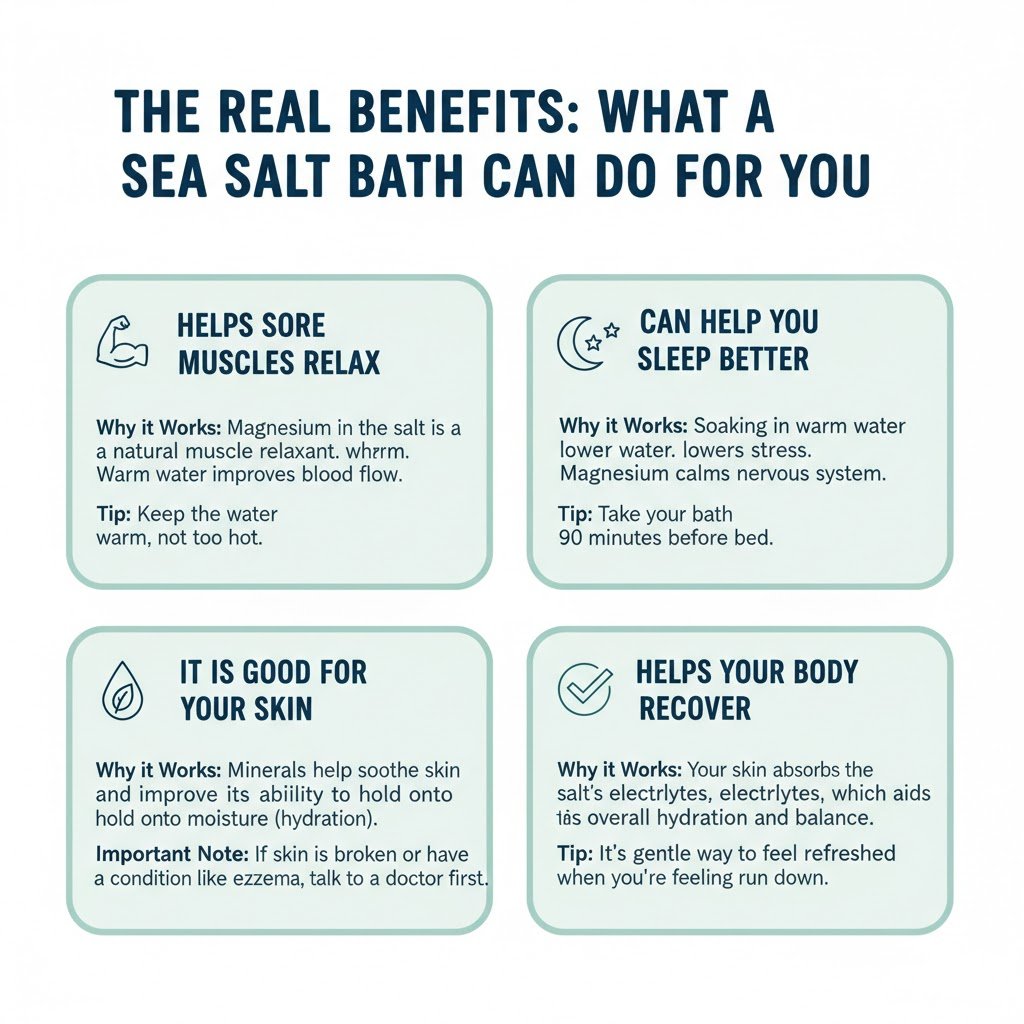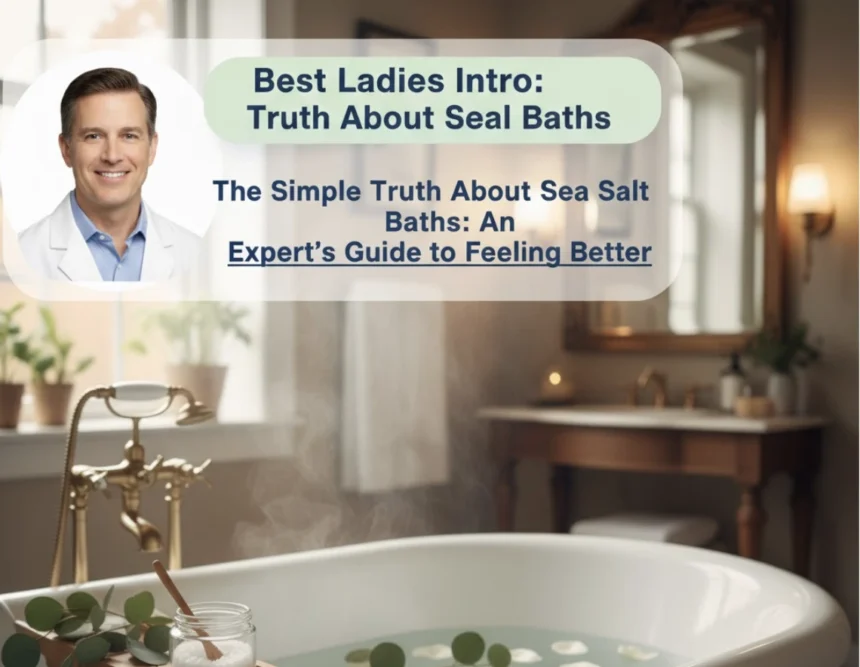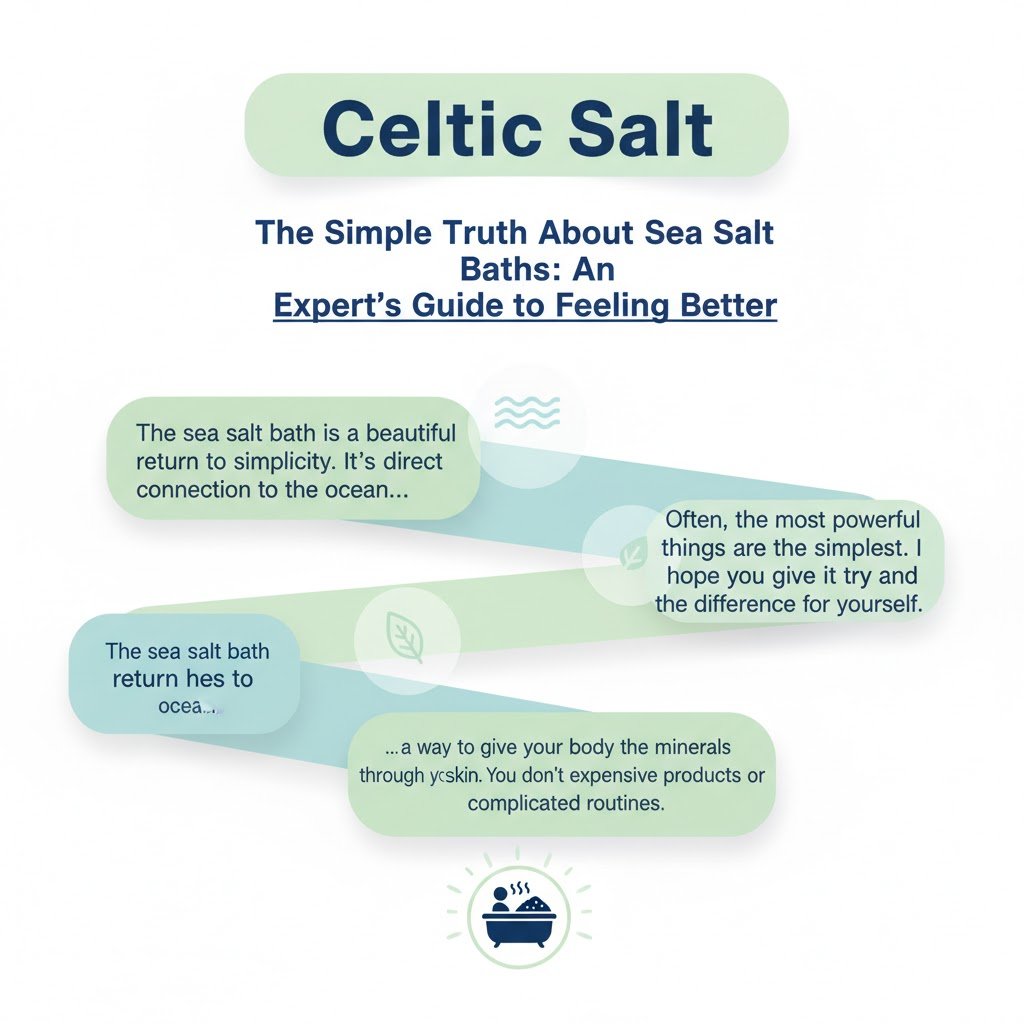My First Real Sea Salt Bath
I remember the first time I truly understood the power of a sea salt bath. It wasn’t in a fancy spa. It was in my own small bathroom after a long, cold day of hiking. My muscles were tight and complaining. A hot bath with a generous scoop of Celtic sea salt changed everything. The sharp, aching feeling melted away, replaced by a deep sense of calm. It felt different from any other bath I’d taken. That was the moment I stopped thinking of salt as just a cooking ingredient and started my journey to learn all about it.
Hi, I’m Rachel, and for the last 15 years, I’ve studied how natural salts from different parts of the world can help our bodies. Today, I want to share what I know with you, in the simplest way possible.
As a doctor at Doctiplus, I verify the health information we provide. My role is to ensure every article and guide is accurate, safe, and based on reliable medical knowledge, so you can trust the advice you find here.
What is a Sea Salt Bath, Really?
At its core, a sea salt bath is very simple. You add natural salt from the sea to your warm bathwater. But it’s more than just salty water.
Think of it like this: your skin is smart. It can absorb minerals from the water. Sea salt is full of these minerals.
The most important one is magnesium. Many people don’t get enough magnesium from their food. This can lead to:
- Tight muscles
- Trouble sleeping
- Feeling tired
When you take a sea salt bath, your skin soaks up the magnesium from the water. It’s a direct way to help your body.
Why Celtic Sea Salt is Different
You can use any pure sea salt, but I often choose Celtic sea salt, especially from the coast of France. Here’s a simple breakdown of why it’s special:
| Feature | Regular Table Salt | Celtic Sea Salt |
|---|---|---|
| Processing | Heavily processed; minerals removed. | Raked by sun and wind; minerals stay inside. |
| Minerals | Almost pure sodium. | Contains over 60 trace minerals, including magnesium, potassium, and calcium. |
| Color & Feel | Pure white, fine grains. | Slightly grey, moist, coarse crystals. |
| How it Helps | Can dry out the skin. | Nourishes the skin with minerals. |
An Expert’s Note: The grey color comes from the clay lining the salt ponds. This clay is rich in minerals that become part of the salt. This is a detail you only learn by visiting the salt farms, as I have. It’s this natural process that makes it so beneficial.
The Real Benefits: What a Sea Salt Bath Can Do For You

Let’s break down the main reasons you might want to try a sea salt bath.
1. It Helps Sore Muscles Relax
This is the benefit most people notice first. After a workout or a long day on your feet, your muscles can feel stiff.
- How it works: The magnesium in the sea salt is a natural muscle relaxant. Warm water helps by improving blood flow. Together, they tell your tight muscles it’s time to let go.
- My Advice: For the best results, the water should be warm, but not so hot that it makes you sweat a lot. You want to relax, not cook.
2. It Can Help You Sleep Better
If your mind is busy when you go to bed, a sea salt bath in the evening can be a great help.
- How it works: Soaking in warm water naturally helps lower your stress. The magnesium also helps calm your nervous system. It tells your body, “The day is over. It’s time to rest.”
- Personal Anecdote: I always recommend a bath about 90 minutes before bed. This gives your body temperature time to drop after the bath, which is a natural signal for sleep. I’ve found this works better than any sleep-tracking app.
3. It Is Good for Your Skin
Sea salt baths can help with itchy, dry, or irritated skin.
- How it works: The minerals in the salt can help soothe skin. It also helps your skin hold onto moisture. Think of it as giving your skin a drink of mineral-rich water.
- Important: If you have very broken skin or a serious condition like eczema, talk to your doctor first, as salt can sting.
4. It Helps Your Body Recover
When you’re feeling run down or just getting over a cold, a sea salt bath can support your body.
- How it works: Your skin absorbs the electrolytes from the salt, which helps with hydration and overall balance. It’s a gentle way to feel refreshed.
How to Take a Proper Sea Salt Bath: An Expert’s Step-by-Step Guide
This is not complicated, but a few small changes can make a big difference.
- Choose Your Salt: Use a high-quality, unrefined sea salt like Celtic or Himalayan salt. You want to see color in the salt—grey, pink, or off-white—because that means the minerals are still there.
- Get the Amount Right: This is where most people use too little. For a standard bathtub, use 1 to 2 cups of salt. For a very therapeutic soak, you can use up to 4 cups. Don’t worry, it’s not wasteful; it’s effective.
- Set the Water Temperature: Make the water warm and comfortable. A good test is that you can get in without it feeling too hot. Extremely hot water can be hard on your body.
- Dissolve the Salt: As the tub is filling, pour the salt under the running water. This helps it dissolve completely.
- Soak for the Right Time: Stay in the bath for 15 to 30 minutes. This gives your body enough time to absorb the minerals without overdoing it.
- Rest Afterwards: When you get out, pat your skin dry gently. Don’t shower afterwards. You want the mineral layer to stay on your skin. Then, drink a large glass of water and rest for at least 15 minutes. Let the benefits sink in.
A Simple Recipe for a Good Night’s Sleep
- 1-2 cups of Celtic sea salt
- 1/2 cup of Epsom salt (for extra magnesium)
- 5-10 drops of lavender essential oil (optional, for calm)
Mix these into a warm bath and soak for 20 minutes before bed.
Common Questions, Answered Simply
Q: Can I use table salt?
A: No. Table salt is just sodium and has additives to keep it from clumping. It doesn’t have the minerals we need and can dry your skin.
Q: How often should I take a sea salt bath?
A: For most people, 2-3 times a week is a good amount. Listen to your body. If it makes you feel good, it’s probably the right choice.
Q: Will it sting if I have a cut?
A: Yes, it will. It’s best to avoid salt baths if you have any open cuts or wounds.
Final Thought from an Expert
The sea salt bath is a beautiful return to simplicity. It’s a direct connection to the ocean, a way to give your body the minerals it needs through your skin. You don’t need expensive products or complicated routines. Often, the most powerful things are the simplest. I hope you give it a try and feel the difference for yourself.
The Complete Guide to Sea Salt Baths – Easy Way
Welcome to the most complete guide you will find on sea salt baths. My name is Rachel, and I have dedicated my life to understanding therapeutic salts. In this section, we will look at every part of this topic. We will cover the science, the history, and the practical steps. My goal is to give you all the information you need in a clear and useful way.
Part 1: The Science of Salt and Skin
To understand why a sea salt bath works, we need to understand our skin and how it interacts with salt water.
Our skin is not a solid barrier. It is a living organ that can absorb things from its environment. This process is called transdermal absorption. When you sit in a bath, the warm water opens up your pores. This allows the minerals dissolved in the water to pass through the outer layer of your skin and enter your body.
The key player here is magnesium. Magnesium is involved in over 300 different chemical reactions inside your body. It helps with:
- Creating energy from the food you eat
- Making new proteins
- Keeping your nerves and muscles working properly
- Keeping your bones strong
Many people do not get enough magnesium from their diet. Modern farming can deplete the soil of minerals, so even healthy vegetables might not have as much as they used to. This widespread lack of magnesium is one reason why sea salt baths can have such a noticeable effect. You are giving your body a direct source of a mineral it needs.
The other minerals in sea salt, like potassium and calcium, also play supporting roles. They are electrolytes. Electrolytes help conduct the tiny electrical signals that your nerves use to communicate. They also help balance the fluids in your body. When you soak in a sea salt bath, you are essentially recharging your body’s mineral and electrolyte levels through your skin.
This is different from drinking salt water, which can be hard on your stomach and kidneys. The skin provides a slow, steady, and gentle way to absorb these nutrients.
Part 2: A Closer Look at Different Salts
Not all salts are created equal. The way salt is harvested and processed makes a huge difference to its mineral content and its effect on your body.
Celtic Sea Salt:
As we discussed, Celtic sea salt is my top choice for a therapeutic bath. It is harvested by hand using a method that is over 2,000 years old. Salt farmers in places like Guérande, France, channel seawater into a series of clay-lined ponds. The sun and wind slowly evaporate the water, leaving behind the salt crystals. Because the ponds are lined with clay, the salt absorbs a rich array of minerals from that clay. This is what gives it its characteristic grey color and moist texture. This minimal processing is why it retains over 60 trace minerals.
Himalayan Pink Salt:
Himalayan salt is another popular choice. It comes from ancient sea beds in Pakistan and is mined from the earth. Its pink color comes from trace amounts of iron oxide (rust). It is also very rich in minerals. Some experts argue that because it is mined and not from a current ocean, its mineral profile might be slightly different. However, it is still an excellent, mineral-rich salt for bathing.
Dead Sea Salt:
This is a special case. Dead Sea salt comes from the Dead Sea, which is so salty that almost nothing can live in it. Its mineral composition is very different from ocean water. It has very high levels of magnesium, potassium, and bromides. It is particularly known for helping with skin conditions like psoriasis. A word of caution: Dead Sea salt should not be used in the same high quantities as Celtic or Himalayan salt. A cup or less is usually enough, as it is extremely potent. It is also important to avoid getting Dead Sea salt water in your eyes or mouth.
Epsom Salt:
Technically, Epsom salt is not a sea salt. Its chemical name is magnesium sulfate. It is a different compound altogether. However, it is fantastic for baths because it is a concentrated source of magnesium. Many people, including myself, like to mix Epsom salt with Celtic sea salt for a bath that delivers a powerful magnesium boost along with the full spectrum of sea minerals.
Here is a table to compare them for bathing:
| Salt Type | Key Feature | Best For | How Much to Use |
|---|---|---|---|
| Celtic Sea Salt | Full spectrum of ocean minerals; moist texture. | Overall wellness, muscle relaxation, mineral replenishment. | 1-2 cups per bath. |
| Himalayan Salt | Rich in minerals; dry, pink crystals. | Skin health, relaxation, detoxification. | 1-2 cups per bath. |
| Dead Sea Salt | Very high in magnesium and potassium; not for ingestion. | Skin conditions like psoriasis, deep muscle aches. | 1/2 to 1 cup per bath. |
| Epsom Salt | Pure magnesium sulfate; not a true salt. | Intense muscle relaxation, reducing swelling. | 1-2 cups per bath. |
Part 3: Detailed Benefits and the Body Systems They Help
Let’s expand on the benefits and look at exactly how they work on different parts of your body.
The Musculoskeletal System (Your Muscles and Bones)
- Mechanism: Magnesium’s primary role in muscle function is to act as a calcium blocker. Calcium is what makes your muscles contract. When a muscle is supposed to relax, magnesium helps by pushing the calcium out of the muscle cells. If you are low in magnesium, calcium can stay in the cells, keeping the muscle in a state of contraction. This leads to cramps, spasms, and that general feeling of tightness. Soaking in a magnesium-rich bath directly supplies this crucial mineral, helping your muscles relax properly.
- Expert Advice: For athletes or anyone with chronic muscle pain, I recommend a post-activity bath 2-3 times a week. Use a mix of 1 cup Celtic sea salt and 1 cup Epsom salt. The combination of sea minerals and concentrated magnesium is very effective.
The Nervous System (Your Nerves and Stress Levels)
- Mechanism: Magnesium is vital for the function of the GABA receptors in your brain. GABA is a neurotransmitter that calms nervous activity. It’s like a natural “brake” for your brain. Low magnesium levels are linked to anxiety, irritability, and trouble sleeping. By raising your magnesium levels through the skin, you are supporting your body’s ability to produce GABA and calm down.
- Personal Anecdote: I have worked with many clients who have high-stress jobs. One of the simplest and most effective recommendations I give is to establish a “wind-down” bath ritual. It’s not just about the minerals; it’s about the act of taking 20-30 minutes for quiet, solitary relaxation. The warm water, the minerals, and the quiet time work together to signal a clear end to the stressful part of the day.
The Integumentary System (Your Skin)
- Mechanism: The skin is your body’s largest organ, and it needs minerals to stay healthy. The trace minerals in sea salt can help improve skin barrier function, which helps your skin hold onto water and stay hydrated. The slight antiseptic property of salt can also help keep minor skin bacteria in check, which is why salt baths are often recommended for acne-prone skin on the body. For conditions like eczema and psoriasis, the anti-inflammatory effects of magnesium and the specific minerals in Dead Sea salt can reduce redness and itching.
- Expert Advice: If you have sensitive skin, start with a lower concentration of salt, like 1/2 cup per bath, and see how your skin reacts. Always moisturize after your bath with a simple, natural oil or lotion to lock in the hydration.
The Circulatory and Lymphatic Systems
- Mechanism: Warm water causes your blood vessels to widen, a process called vasodilation. This improves blood flow throughout your body. Improved circulation means more oxygen and nutrients are delivered to your tissues, and waste products are carried away more efficiently. The lymphatic system, which is part of your immune system, doesn’t have a pump like the heart. It relies on muscle movement and pressure changes to move lymph fluid. The pressure from the water and the improved circulation from the warmth can help support the flow of lymph, helping your body clear out toxins.
- Important Note: The word “detox” is often overused. Think of it less as a “cleanse” and more as giving your body’s natural waste-removal systems a helping hand. A sea salt bath supports the organs your body already uses to stay clean.
Part 4: Creating Your Own Bath Rituals
You can customize your sea salt bath for different needs. Here are a few simple recipes I have developed and used with my clients over the years.
The “After-Workout” Recovery Bath
- Goal: Reduce muscle soreness and speed up recovery.
- Recipe:
- 1 cup Celtic Sea Salt
- 1 cup Epsom Salt
- Instructions: Add salts to a warm (not hot) bath. Soak for 20 minutes within two hours of your workout.
The “Good Night’s Sleep” Bath
- Goal: Calm the mind and prepare the body for deep sleep.
- Recipe:
- 1 cup Celtic Sea Salt
- 1/2 cup Epsom Salt
- 5-10 drops of Lavender Essential Oil
- Instructions: Take this bath about 90 minutes before you plan to go to sleep. The drop in your body temperature after the bath is a key signal for sleep. Keep the lights low and avoid looking at screens.
The “Skin Soothing” Bath
- Goal: Calm irritation, redness, and mild itchiness.
- Recipe:
- 1/2 cup Dead Sea Salt
- 1/2 cup Oatmeal (place dry oatmeal in a sock or muslin bag and let it steep in the bathwater like a tea bag)
- Instructions: Use lukewarm water, as hot water can further irritate sensitive skin. Soak for 15-20 minutes. The oatmeal provides an additional soothing layer for the skin.
Part 5: Addressing Common Concerns and Mistakes
Mistake #1: Using water that is too hot.
Very hot water can stress your body, raise your heart rate, and strip your skin of its natural oils. It can be counterproductive. Warm water is much more effective for relaxation and mineral absorption.
Mistake #2: Not using enough salt.
A few tablespoons in a large bathtub will not have a noticeable therapeutic effect. Think of the ocean; it’s very salty. To get the benefits, you need a significant amount. One to two cups is the standard recommendation for a reason.
Mistake #3: Rinsing off in the shower afterwards.
This washes away the mineral layer on your skin. Pat yourself dry and let that mineral film continue to be absorbed.
Mistake #4: Not drinking water.
Soaking in warm water can make you sweat and lose fluids. It is important to rehydrate by drinking a large glass of water before or after your bath.
Concern: I have high blood pressure. Can I use sea salt baths?
This is a common question. Soaking in a salt bath is very different from eating salt. The minerals are absorbed transdermally and do not cause a sudden increase in blood sodium levels in the way that eating a salty meal would. However, if you have any serious health condition, it is always best to check with your doctor before starting any new health practice.
Part 6: The Bigger Picture – A Return to Simple Wellness
In my years of research and practice, I have seen a clear trend: people are looking for ways to feel better that are natural, simple, and empowering. A sea salt bath fits this perfectly. It is a practice that puts you in charge of your own well-being. It doesn’t require a prescription or expensive equipment. It connects you to the natural world in a direct way.
The ocean is the source of all life on our planet. Our own blood plasma has a mineral composition remarkably similar to that of seawater. When we take a sea salt bath, we are reconnecting with that primal, life-giving source. We are giving our bodies the same minerals that have supported life for millions of years.
This is not a magic cure. It is a supportive practice. When combined with good nutrition, adequate water intake, and manageable stress levels, a regular sea salt bath can be a cornerstone of a healthy, balanced life. It is a small act of self-care that pays large dividends in how you feel every day.
I hope this guide has been helpful for you. My goal is to share this knowledge so that you can make informed choices about your health. Thank you for reading.


